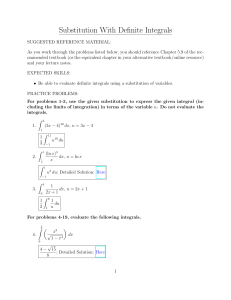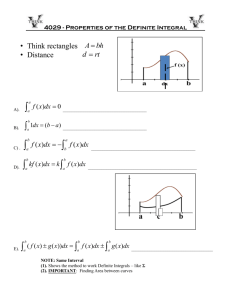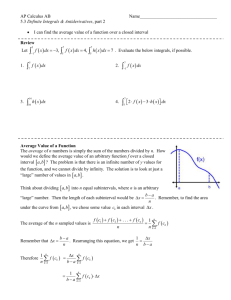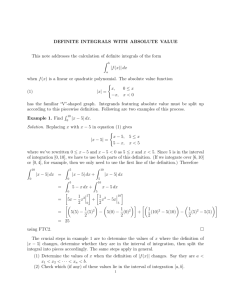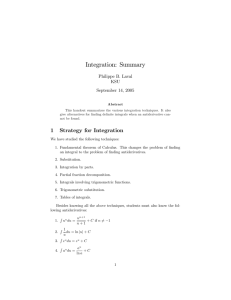Anti-derivatives/Indefinite Integrals of Basic Functions
advertisement
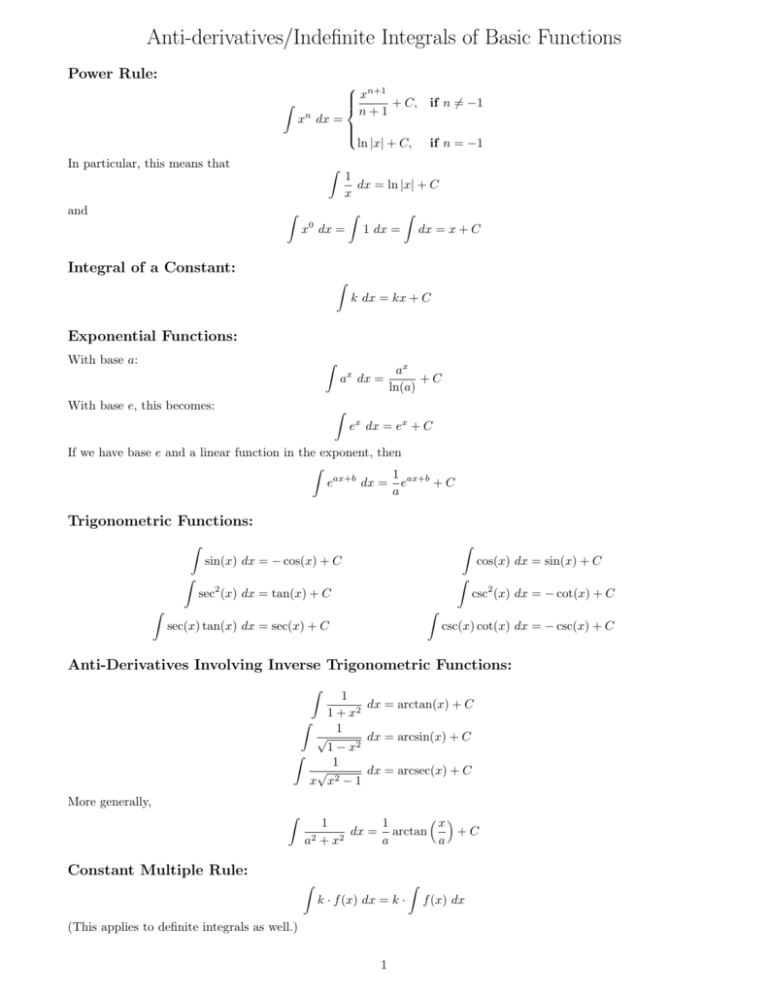
Anti-derivatives/Indefinite Integrals of Basic Functions
Power Rule:
n+1
x
Z
+ C,
n
+1
xn dx =
ln |x| + C,
if n 6= −1
if n = −1
In particular, this means that
Z
and
Z
1
dx = ln |x| + C
x
x0 dx =
Z
Z
1 dx =
dx = x + C
Integral of a Constant:
Z
k dx = kx + C
Exponential Functions:
With base a:
Z
ax dx =
ax
+C
ln(a)
With base e, this becomes:
Z
ex dx = ex + C
If we have base e and a linear function in the exponent, then
Z
1
eax+b dx = eax+b + C
a
Trigonometric Functions:
Z
Z
sin(x) dx = − cos(x) + C
Z
cos(x) dx = sin(x) + C
Z
sec2 (x) dx = tan(x) + C
Z
csc2 (x) dx = − cot(x) + C
Z
csc(x) cot(x) dx = − csc(x) + C
sec(x) tan(x) dx = sec(x) + C
Anti-Derivatives Involving Inverse Trigonometric Functions:
Z
1
dx = arctan(x) + C
1 + x2
Z
1
√
dx = arcsin(x) + C
1 − x2
Z
1
√
dx = arcsec(x) + C
x x2 − 1
More generally,
Z
x
1
1
dx
=
arctan
+C
a2 + x2
a
a
Constant Multiple Rule:
Z
Z
k · f (x) dx = k ·
(This applies to definite integrals as well.)
1
f (x) dx
Sum/Difference Rule:
Z
Z
f (x) ± g(x) dx =
Z
f (x) dx ±
g(x) dx
(This applies to definite integrals as well.)
Other Properties of Definite Integrals:
•
Rb
Ra
f (x) dx = − f (x) dx
a
•
Ra
b
f (x) dx = 0
a
•
Rb
f (x) dx +
a
Rc
b
f (x) dx =
Rc
f (x) dx
a
Ra
• If f is even [i.e., f (−x) = f (x)], then
f (x) dx = 2 ·
−a
• If f is odd [i.e., f (−x) = −f (x)], then
Ra
f (x) dx
0
Ra
f (x) dx = 0
−a
Integration Theorems and Techniques
Riemann Sums and Approximating Definite Integrals
Approximate the net area under the graph of f (x) over the interval [a, b] using n rectangles and the indicated
end/mid-point, where
b−a
; x0 = a, xi = a + i · ∆x, xn = b;
n
• Left End-point Approximation:
∆x =
xi =
xi−1 + xi
(the midpoint of the interval [xi−1 , xi ])
2
Zb
f (x) dx ≈ Ln = ∆xf (x0 ) + ∆xf (x1 ) + . . . + ∆xf (xn−1 )
a
= ∆x [f (x0 ) + f (x1 ) + . . . + f (xn−1 )]
=
n−1
X
f (xi )∆x
i=0
• Right End-point Approximation:
Zb
f (x) dx ≈ Rn = ∆xf (x1 ) + ∆xf (x2 ) + . . . + ∆xf (xn )
a
= ∆x [f (x1 ) + f (x2 ) + . . . + f (xn )]
n
X
=
f (xi )∆x
i=1
• Mid-point Approximation:
Zb
f (x) dx ≈ Mn = ∆xf (x1 ) + ∆xf (x2 ) + . . . + ∆xf (xn )
a
= ∆x [f (x1 ) + f (x2 ) + . . . + f (xn )]
n
X
=
f (xi )∆x
i=1
2
Formal Definition of a Definite Integral
Let f be defined on the interval [a, b], and let [a, b] be partitioned into n subintervals, ∆xi be the length of the ith
subinterval and xi any point in that subinterval. If the limit
lim
n
X
n→∞,
∆x→0 i=1
f (xi ) · ∆xi ,
exists, then we say f in integrable on [a, b] and denote that limit by
Zb
f (x) dx = n→∞,
lim
n
X
f (xi ) · ∆xi ,
∆x→0 i=1
a
To make this definition a little easier to work with, we force the size of ∆x to be uniform and dependent on n, and
then define xi in terms of ∆x and i:
b−a
∆x =
, xi = a + i · ∆x
n
and then the definition becomes
Zb
n
X
f (x) dx = lim
f (xi ) · ∆x
n→∞
a
i=1
The Fundamental Theorem of Calculus:
Suppose f is continuous on the closed interval [a, b].
1. If g(x) =
Rx
f (t) dt, then g 0 (x) = f (x). [Also called the Second Fundamental Theorem of Calculus.]
a
2.
Rb
f (x) dx = F (b) − F (a), where F is any antiderivative of f , i.e., F 0 = f . [Also called the Evaluation
a
Theorem.]
u-Substitution:
If u = g(x) is a differentiable function whose range is an interval I and f is continuous on I, then
Z
Z
0
f (g(x)) g (x) dx = f (u) du
General Steps:
1. Let u = (some function of x). u is a function whose derivative (up to a constant multiple) appears in the
integrand and/or usually the inside of a composition. It may not always be immediately obvious what u should
be or that it’s derivative is in the integrand, but with practice you’ll start to build a library of common “tricks”
and it will become easier/faster.
2. Rewrite the integral in terms of u (changing expressions with x’s and dx to expressions with u’s anddu). If you
have a definite integral, then you can convert the limits of integration to u’s and evaluate everything in terms
of u without changing back to x’s:
Zb
g(b)
Z
f (g(x)) g (x) dx =
f (u) du
0
a
g(a)
If you choose not to do this, then you should write “x =” in your limits of integration until you change back
to x’s at the end.
Either way, you should end up with an integrand in terms of only u, and this integral should be easier to
evaluate than the one with which you started.
3. Evaluate this simpler u integral.
3
4.
• If you have an indefinite integral, reverse the substitution to change your final answer back to x’s by
replacing all u’s with whatever they are in terms of x (based on your original substitution).
• If you have a definite integral and changed your limits to u’s back in step 2, then simply use the Fundamental Theorem as usual (without changing back to x’s!). If you left your limits as x’s in step 2, then
you need to reverse the substitution (get answer back to x’s) and then use the Fundamental Theorem.
Integration by Parts:
Z
Z
u · dv = u · v −
v · du
When choosing u and dv, we want a u that will become simpler (or at least no more complicated) when we differentiate
it to find du, and a dv what will also become simpler (or at least no more complicated) when we integrate it to find
v. If you’re having trouble deciding what u and dv should be to accomplish this, you can use “LIATE” to choose u
(choose as high on the list as possible):
1. Logarithmic
2. Inverse Trigonometric
3. Algebraic (such as polynomials [including powers of x] and rational functions)
4. Trigonometric
5. Exponential
and then whatever is left is dv. This doesn’t always work, but it’s a good place to start.
Trigonometric Integrals
For integrals involving only powers of sine and cosine (both with the same argument):
• If at least one of them is raised to an odd power, pull off one to save for a u-sub, use the Pythagorean identities
to convert the remaining (now even) power to the other trig function, then make a u-sub with u =(whatever
trig function you didn’t save), and then the trig function you set aside earlier will be part of du.
• If they are both raised to an even power, use the half-angle formulas (cos2 (x) = 12 (1 + cos(2x)), sin2 (x) =
1
2 (1 − cos(2x))) to convert to cosines, expand the result and apply half-angle formula again if needed (keep
doing this until you no longer have any powers of cosine), then integrate (may need a simple u-sub).
Trigonometric Substitutions
If the integral contains an
expression of the form...
√
√
√
...then make the
substitution...
...and...
a2 − x2
x = a sin θ
dx = a cos(θ) dθ
a2 + x2
x = a tan θ
dx = a sec2 (θ) dθ
x2 − a2
x = a sec θ
dx = a sec(θ) tan(θ) dθ
Partial Fraction Decomposition
Given a rational function to integrate, follow these steps:
1. If the degree of the numerator is greater than or equal to that of the denominator perform long division.
2. Factor the denominator into unique linear factors or irreducible quadratics.
4
3. Split the rational function into a sum of partial fractions with unknown constants on top as follows:
A
ax + b
| {z }
for a linear factor
For example:
+
B
C
+
+
cx + d (cx + d)2
|
{z
}
for a repeated linear factor
Dx + E
ex2 + f x + g
|
{z
}
for an irreducible quadratic
Dx + E
x2 + 7
A
B
C
+ 2
=
+
+
2
2
2
(2x + 1)(x − 3) (x + 3x + 1)
2x + 1 x − 3 (x − 3)
x + 3x + 1
4. Multiply both sides by the entire denominator and simplify.
5. Solve for the unknown constants by using a system of equations or picking appropriate numbers to substitute
in for x.
6. Integrate each partial fraction.
Z
(You may need to use u-substitution and/or
x2
x
1
1
dx = tan−1
+ C).
2
+a
a
a
5





